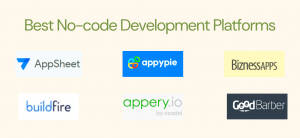The application development domain is evolving with leaps and bounds. And the two technologies currently stealing the spotlight include low-code and no-code app development. With several similarities between no-code and low-code application development, it is easy to confuse both terms.
In this blog, we’ll dive into the details of low-code and no-code application development and discuss the difference between the two.
Let’s get started!
What is low-code Development?
- Low-code application development involves constructing an application without the aid of complex software programming.
- These tools include drag-and-drop, automatic generation and editing tools, making it easier for software engineers to develop applications.
- This solution is applied in developing websites, mobile apps, and other computational applications that use different operating systems as well as devices with or without internet connections.
- Low-code application development gives developers the ability to create a customized program that works with their customers and business goals. This means you can develop apps that are easy to use, save time and money with minimal effort, and more importantly, highly accurate.
You’ll just need to consider three things for application development using low-code technology:
- Anyone working in the IT domain or enterprise can develop web and mobile applications, given that they dedicate a particular amount of time, have interest and minimum technical aptitude.
- Moreover, any active application will require periodic updates and regular maintenance, so developers need to invest time for consistent post-development support.
- Finally, developers should have a clear understanding of the app utilization and how it’ll support a company’s goals, business priorities and integration into existing workflows.
What is a low-code Development Platform?
If you’re a developer, then you know how hard it is to manage all of the different application development tools and platforms. You have to keep up with new updates, be aware of security threats, and make sure that you know how to use everything in your toolbox.
But what if there was a way for you to use the same tools with different teams? What if you could build apps that are more flexible and powerful than ever before?
That’s what low-code development platforms do!
- A low-code development platform is a web-based application that allows you to create applications without hard-core coding.
- They use a graphical user interface (GUI) or web-based interface to allow developers to build apps without having to write code or learn how to program.
- The platform is typically built on top of an existing framework, such as Ruby on Rails or Laravel, that handles the back-end logic.
- You just need to write your UI (user interface) in HTML, CSS, and JavaScript.
- Low-code platforms are often referred to as “drag-and-drop” platforms.
- Low-code development platforms are softwares that are designed to help developers create applications quickly and efficiently.

Who can benefit from low-code app development platforms?
- Low-code development platforms are mainly used by non-technical teams or individuals who want to build an app but do not have the time, experience or skill set to develop it themselves.
- It’s also a good choice for companies that have existing code bases they want to integrate with and reuse but don’t want to spend the time and money recreating everything from scratch.
- This can even be a great option for developers who want to learn how to code but don’t want to build everything themselves.
- They can also be used by small businesses that want to create their own apps but do not have the budget for more expensive options like full-stack development platforms.
What are the benefits of low-code development?
- Easy and efficient – It is easier to create an ‘interactive’ application as it can be created without having to write extensive code. It is also efficient because you do not have to write all of the code for your application.
- Fast prototyping – It takes less time to develop prototypes as you don’t have to write all the application logic in your first iteration. This helps you test your designs faster and validate user feedback quickly before spending more time on design details.
- Less waste – No more wasted effort writing boilerplate files or making small changes over and over again until something works properly!
- Accessibility – You don’t have to worry about hardware requirements or server setup – everything runs straight through your browser!
- Less complexity – It also uses an approach called “single-page” design, which means that each page of your application functions as a standalone entity rather than as part of a larger whole. This allows you to focus on only one thing at a time and gives your users (or potential customers) the impression that they’re interacting with one unitary system rather than several different ones.
- Easy maintenance – Low-code development means that your application will be easier to maintain in the long run because it won’t require as many updates or changes over time.
- Affordable – The cost of creating and maintaining these types of applications is much lower than traditional applications because there is no programming involved.
- Easy to deploy – Low-code applications can be easily deployed on cloud platforms like AWS or Azure.
- Efficient market expansion – Low-code applications are more flexible and customizable, which means you can easily distribute them to different users, locations, or platforms. This makes it easier for your business to expand into new markets and services.
All these benefits ultimately mean less work for you, which translates into happier clients and happier employees!
No-Code Application Development
- No-code application development is a methodology that allows businesses or developers to build their own applications without having to write any code. In other words, you don’t have to write any Java or other programming languages in order to create applications for your own business or organization.
- Instead, you can use existing programming languages and a combination of tool sets to build the apps you need without having to learn how to program in those languages themselves. This includes tools like Microsoft Visual Studio or Adobe Photoshop. It can also be built using some third-party tools such as NetBeans or JDeveloper.
- These include visual designers, code generators and other tools that allow the team to build software without writing any code.
- It’s an approach that has been used for decades, and it works for many different kinds of software applications. In fact, it’s often the only way to build complex applications without using any code at all.
Why is this so important? To understand the answer, let’s explore the benefits of no-code application development.

What are the benefits of no-code application development?
- Convenient – There are no limits on what kind of business you can develop with this method because there are no restrictions on the types of applications that can be made using no-code application development methods.
- Efficient – You don’t have to worry about whether or not your custom-built software will work on different platforms like Windows phones or Mac computers; instead, all platforms will work with each other because they are all based on the same underlying platform.
- Affordable – It’s not just about convenience; it’s about cost savings for small businesses and organizations who don’t have the resources or expertise needed to develop an application from scratch on their own.
- Time-saving and easy – No-code application development can also help you cut down your time to market and reduce costs by eliminating the need for multiple developers.
- Less prone to error – This is a way to develop applications that can be executed on existing devices, with existing interfaces, using existing systems and databases. This means that your app is more likely to be bug-free and have fewer bugs coming out at launch time.
The most common types of no-code applications include:
- Mobile apps
- Web apps
- Desktop apps
- ERP systems
What is the difference between no-code and low-code application development?
Before you start your next project, you should know the difference between no-code and low-code application development.
| No-code development | Low-code development | |
| Development Principle | The application development process that uses a visual interface to guide the user through the application’s functions | An approach to building applications that emphasizes the use of structured code, which makes it easier to create programs with less effort |
| Coding requirement | Does not require any programming knowledge | Can be created by anyone who is comfortable with a coding language such as HTML or JavaScript |
| Users | Best for developing applications by business users or citizen developers | Best for developing applications by a developer with minimal professional coding knowledge |
| Project Type | Simple applications, especially departmental applications | Critical, sophisticated solutions with strategic goals |
| Code customization | Not possible to incorporate | Adding custom code is possible when necessary |
| Use cases | Can be used for developing applications for the following functions:
|
Can be used for developing applications for the following:
|
Similarities between no-code and low-code application development
- You don’t need to know much about coding or programming to build applications.
- It’s possible to build complex applications without having extensive technical knowledge.
- The typical user interface is simple enough that even non-programmers can use it easily.
- The cost of creating an advanced web application is much lower than building a desktop application because you can reuse most of the code across multiple platforms (web, mobile, and desktop).
- Both are faster and cheaper than high code development.
- Low-code and no-code applications are easier to maintain than high-code applications.
- Both no-code and low-code applications need less time for testing because the developers don’t have to write any tests for them.
- There is no need for manual QA testing in no-code, as well as low-code development because everything is automated.
Frequently Asked Questions
Q: What is low-code?
A: The low-code platform is a software development process that focuses on creating applications with less code.
Q: How does low-code development work?
A: Low-code applications are created by using a visual design tool and writing just the code needed to implement the logic in your application.
Q: Is low coding easy?
A: Yes! You can create an entire application without writing any line of PHP or HTML. You just need to drag and drop different components onto the page and connect them together using links, paragraphs, and notes.
Q: Are low-code applications the same as minimal UI apps?
No, they are not. Low-code applications are complex applications that do not require a UI for users to interface with.
Q: How do I develop low-code apps?
A: You can develop low-code apps using any of the following ways:-
1) Using the drag-and-drop method
2) Using the drag-and-drop method with an automatic data import tool
3) Using visual programming tools like App Inventor, PhoneGap, etc.
Q: How does low-code application development differ from high-code application development?
A: A high code application development uses a programming language that is more complicated than JavaScript, such as C++ or Java, which allows the developer to implement advanced features in their applications, such as animations and user interface components that are not possible with JavaScript alone.
Q: How does no-code application development work?
A: When you use a programming language like Java or JavaScript, each function gets its own file that contains code and instructions on how it should run. With no-code application development, you write your code in plain English instead of code so that anyone can read and understand it. This means that there’s no separate file for each function in your program; instead, all of your functions are combined into one big file called a class or package.
Q: Is no-code application development faster than traditional coding?
A: Yes! No-code apps can be built much faster because there’s no need for any external tools such as IDEs (Integrated Development Environments). In fact, many new tools have been developed specifically for this purpose so that you can spend less duration writing code and more time building great apps.
Q: Why do you need no-code application development?
A: There are several reasons why you should consider using no-code application development:
1) You want to save money on the initial cost of your project.
2) You have a limited budget for your project, and you don’t want to spend more than necessary.
3) You want to get something done quickly without having to spend time learning how to code.
Q: How long does it take to learn no-code?
A: It depends on your background and experience, but it typically takes about 1-2 weeks. Most of the time spent will be spent learning about frameworks and practices, which are the same for both no-code and traditional agile approaches.
Conclusion
If you’ve ever tried to develop an application using web technologies, you’ll know it’s not an easy task. Code needs to be written in different languages or programming frameworks, and it becomes difficult to manage code when you’re building large applications.
With no code and low-code application development, programming is simple, making it easy for even non-programmers to create powerful web applications. It doesn’t matter if you’re a coder, a marketer, a designer, or an entrepreneur – with these technologies, you have the power to build an application today!






Add comment